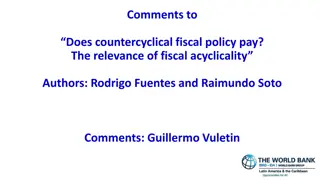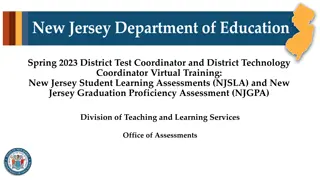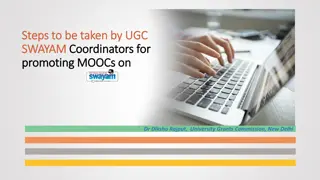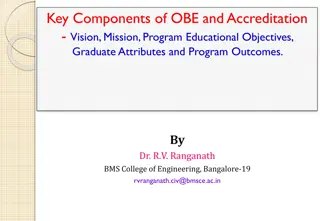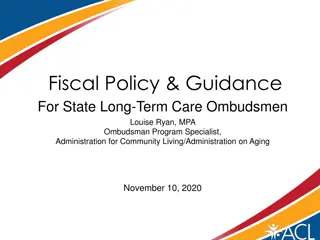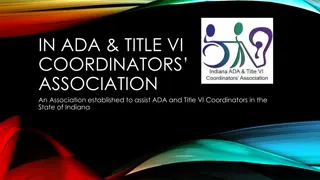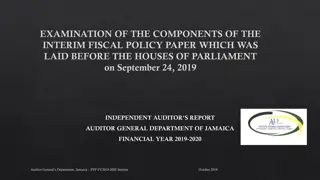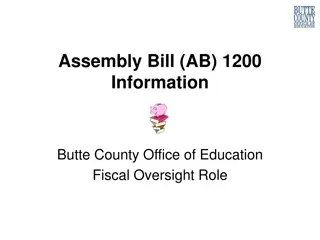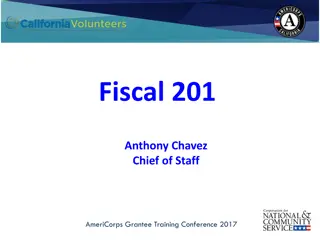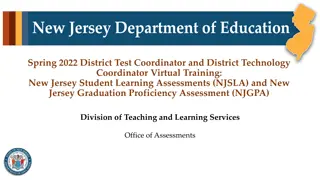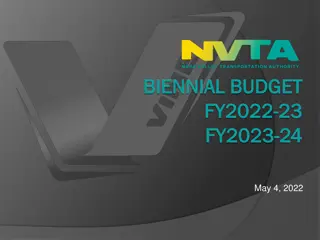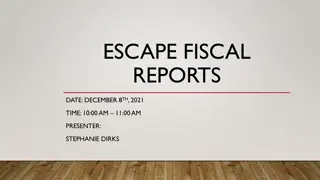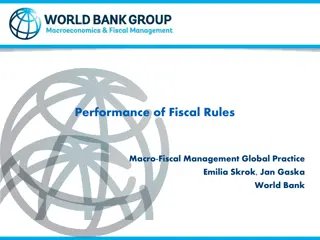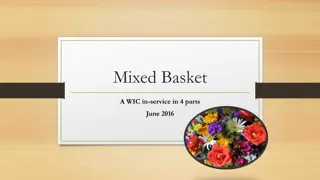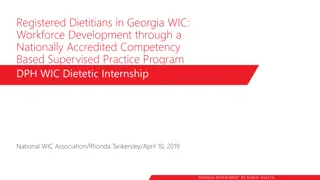WIC Fiscal Training for Local Agency Coordinators
This training aims to help local agency staff effectively utilize their WIC grant awards, understand fiscal review standards, reporting requirements, and access technical assistance. Learn about WIC funding sources, including USDA and OHA, and how funding is determined for local agencies.
Download Presentation

Please find below an Image/Link to download the presentation.
The content on the website is provided AS IS for your information and personal use only. It may not be sold, licensed, or shared on other websites without obtaining consent from the author.If you encounter any issues during the download, it is possible that the publisher has removed the file from their server.
You are allowed to download the files provided on this website for personal or commercial use, subject to the condition that they are used lawfully. All files are the property of their respective owners.
The content on the website is provided AS IS for your information and personal use only. It may not be sold, licensed, or shared on other websites without obtaining consent from the author.
E N D
Presentation Transcript
WIC fiscal training for local agency coordinators and fiscal staff
Objectives for this training Local agency staff can utilize their WIC grant award effectively to maximize program impact. Local agency staff will understand the fiscal review standards and reporting requirements. Local agency staff will know where to get technical assistance and answers to questions on different fiscal issues.
Where does WIC funding come from? Through regional office USDA Glossary of acronyms USDA United States Department of Agriculture OHA Oregon Health Authority PHD Public Health Division Through PHD OHA Your agency
Where does WIC funding come from? USDA OHA Your agency Distributes NSA $ Food $ Distributes NSA $ Uses NSA $ for program operations NSA (Nutrition Services and Administration) funding is used to pay for things like program administration, staffing, overhead, and paying for WIC services other than food. Food funding only pays for WIC food benefits and breast pumps. OHA distributes NSA funding to local agencies for their program operations. OHA uses food funding to handle all reimbursement of vendors for food benefits.
Other funding Farm Direct Nutrition Program USDA OHA State General Fund support for FDNP Glossary of acronyms FDNP Farm Direct Nutrition Program, also known as WIC Farmers Market Your agency Some agencies get funds from their organizations
Other funding OHA Formula rebates come from the formula company that provides WIC s contract formula. Rebate funds are used as part of WIC food dollars. Formula rebates Your agency
How is local agency funding determined? Each agency is assigned a caseload number based on how many participants they have been serving and the need in their service area. Assigned caseload determines your agency funding. Assigned caseload is set by the state WIC office every year in March for grant funding starting July 1. See Policy 305 Funding Formula for more information. Policy 305 Funding Formula Assigned Caseload The per participant rate is established by the state WIC office every year in March for grant funding starting July 1. The per participant rate and your assigned caseload determine the funding for your agency. Grant funding notification letters are sent from the state WIC office to agencies in May. Per participant rate
Smaller Agencies Receive Additional Money - Caseload Tiers Tier 1 Caseload equal to or greater than 5,000 No additional funding Agencies receive additional funding based on caseload tiers. The amount varies each year depending on federal funding. Agencies will be notified of the amount of the tier- based funding in WIC NSA Funding and Grant letter. These are the minimum amount agencies will receive. Tier 2 Caseload greater than 1,500 and <5,000 No additional funding Tier 3 Caseload greater than 1,000 and 1,500 $2000 additional funding per year Tier 4 Caseload equal to or less than 1,000 $4000 additional funding per year
How do contracts work? The contract between the state Public Health LPHA office and Policy 310 Contract Process for Local Programs your agency is sent separately in May or June. The contract covers July 1 through June 30. Your local agency administrator signs and submits the contract to the LPHA office. See Policy 310 Contract Process for Local Programs for more information. If completed contracts are not submitted by the deadline, agencies will not receive their WIC funding on time. Policy 310 Contract Process for Local Programs Contracts Required expenditures The contract specifies required expenditure amounts for nutrition education (NE) and breastfeeding support and promotion (BF).
MORE ON REQUIRED EXPENDITURES Nutrition Education (NE) and Breastfeeding Support and Promotion (BF) A specific dollar amount you must spend on Nutrition Education (NE) and Breastfeeding Support and Promotion (BF) will be cited in your WIC NSA Funding and Grant letter. Nutrition Education (NE) 20% of the total WIC grant (NSA) must be spent on Nutrition Education (NE). Nutrition Education (NE), Breastfeeding Support and Promotion (BF), Client Services (CS), General Administration (GA) The actual dollar amount your agency spent on NE, BF, CS, and GA are required fields on the Quarterly Expenditure and Revenue Report.
How are funds received? Agencies receive 1/12th of their total annual funding every month starting July 1. These payments are reconciled quarterly. There are certain situations where funds can be carried over to the next month. To understand how this works, you need to understand how WIC fiscal years work.
Understanding the 2 types of WIC fiscal years State Fiscal Year June July Aug Sept Oct Nov Dec Jan Feb Mar Apr May June July Aug Sept State fiscal year July 1 to June 30 WIC is run through a state agency Oregon Health Authority, Public Health Division and must follow their fiscal processes and rules. The WIC grant and contract match the state fiscal year July 1 through June 30.
Understanding the 2 types of WIC fiscal years Federal Fiscal Year June July Aug Sept Oct Nov Dec Jan Feb Mar Apr May June July Aug Sept Federal fiscal year October 1 to September 30 WIC is funded through a federal agency US Department of Agriculture, Food and Nutrition Services and must spend our annual grant within the federal fiscal year October 1 through September 30.
Understanding the 2 types of WIC fiscal years State and Federal Fiscal Year Overlap June July Aug Sept Oct Nov Dec Jan Feb Mar Apr May June July Aug Overlap Sept State fiscal year July 1 to June 30 New federal fiscal year October 1 to September 30 This leaves a 3 month overlap from July 1 through September 30. Funds from one federal fiscal year cannot be used in the next federal fiscal year. In order to close out the books for the federal fiscal year, funds from July 1through September 30 (1st quarter) of the state fiscal year have to be spent in that quarter and cannot roll-over to the next federal fiscal year.
Submission of Quarterly Expenditure and Revenue Reports - POLICY 315 FISCAL REPORTING Quarter 1 If agencies do not expend all of the funds received for the first quarter of the State Fiscal Year (July, August, September) by September 30, it cannot be recouped in future quarters. The State will take back any grant funds not expended in the first quarter. Quarters 2-4 After the first quarter, funds may be expended in greater or lesser amounts each quarter as long as all of the funds are expended by June 30 (end of contract year). The State will take back any grant funds not expended in the second thru fourth quarters.
Quarterly Expenditure and Revenue Report Quarterly Expenditure and Revenue Report are due 30 days following the end of the first three quarters and 51 days after the end of the fourth quarter. If any expenditure report has not been received by its deadline, the WIC State payment to the local agencies could be delayed. third quarter first quarter second quarter fourth quarter October September January November February December March May August July April June
Avoid underspending your WIC grant ---- things to consider At the end of every quarter, there are a few agencies that have not submitted Quarterly Expenditure and Revenue Reports showing they ve spent their full WIC grant. When the underspent amount is significant, the State WIC office sends out underspent notices to these agencies in early February and May in hopes they can correct it at the end of the end of the 2nd and 3rd quarters.
Avoid underspending your WIC grant ---- things to consider How many awards do you have from State WIC? Nutrition Services Administration (NSA), Farm Direct Nutrition Program (FDNP), or Breastfeeding Peer Counseling (BFPC)? Save your WIC grant award letters for documentation of the exact award amounts. Do you work closely with fiscal staff to review each award s expenses regularly? Meet at least quarterly, but monthly would be better. For the WIC NSA award, are payroll and other expenses correctly charged to one of these categories: client services, general administration, nutrition education, breastfeeding promotion?
Avoid underspending your WIC grant ---- things to consider Do you and your fiscal staff know underspent Quarter 1 (Jul - Sept) awards cannot be carried over to Quarters 2- 4 (Oct Jun)? Check with your fiscal staff in early September so you can adjust spending in time to avoid underspending in Quarter 1. Do you and your fiscal staff know all Quarters 2-4 awards must be spent by 6/30, and cannot to be carried over to the following fiscal year starting 7/1? What strategy would you use to make sure any remaining WIC funds are spent by 6/30?
WIC budget projection worksheet This worksheet must be completed and submitted by June 30 for the coming fiscal year. Instructions for submission are at the bottom of the form. Other fiscal requirements Annual budget forms are sent to local agencies in late May each year, after caseload letters have been sent out.
Farm Direct is not 100% federally funded. The amount available to spend on farm direct checks varies year to year depending on how much the state legislature allocates, and how many Farm Direct check booklets are assigned to your agency. Local agencies will be notified of their Farm Direct check booklet allocation and administrative funding prior to the beginning of the Farm Direct season. Other fiscal requirements A separate Farm Direct Quarterly Expenditure and Revenue Report must be submitted no later than June 30th for funds expended for the previous season. Use the E&R report form instructions for details. Farm Direct may also be called the WIC farmers market mini grant/fresh veggie funding and WIC farmers market administrative funds.
FarmDirect Farm Direct Mini Grants are authorized for the period July 1st through June 30th (new), and are paid to local agencies as follows: 50% paid July 1st to WIC local agencies 50% paid October 1st to WIC local agencies NEW - grant expenditures must be recorded/posted by June 30th Quarterly Expense and Revenue Reports need to be submitted for every quarter in the fiscal year Farm Direct funds are expended. Final Farm Direct revenue and expenditure report is due on August 20th
Time studies Time study summaries must be submitted quarterly for the months of October, January, April and July. All staff who are paid directly (not by cost allocation) by the WIC grant during the time study month, must complete an individual time study. If the agency captures staff payroll by WIC categories CS, GA, NE, BF then individual time studies are not required. Time studies classify WIC work in four categories below. The majority of WIC staff time is usually spent in nutrition education and client services. Client services (CS) General administration and payroll (GA) Nutrition education (NE) Breastfeeding support and promotion (BF) Time studies are used to corroborate local agency expenses related to those 4 areas of WIC services. Time should be rounded to 15-minute increments, for example If it s 7 minutes, round up to 0 minutes; if it s 8 minutes, round up to 15 minutes. See Policy 316 Quarterly Breakout of Staff Time for more info.
State WIC will reimburse local agencies for expenses incurred for attending required/mandated training and certain meetings (e.g. OWCA, data system training, Breastfeeding Basics). Travel and training State WIC uses the state guidelines regarding meal reimbursements. Reimbursement requests must be submitted to the state by the agency within 4 weeks of the last travel date. The state reimburses the agency, not individual travelers. Reimbursed travel expenses should not be included in the local agency Quarterly Expenditure and Revenue Report. Use the following forms and resources: Policy 340 Reimbursement for Travel Travel matrix and information (e.g. per diems, mileage rate, 70 mile rule) In-state reimbursement form Exemption request for travel expenses
What conferences does the state support? NWA conferences (1 if in person, 4 if virtual) and the Leadership academy How often does the state support attendance? Once per biennium (every 2 years) National WIC Association Conferences and Leadership Academy Who do they contact to request attendance? Email the Nutrition and Local Services Manager, with a cc to your nutrition consultant and Tove Larsen . How many are eligible from each agency to attend conferences? 1 in person; 4 for virtual attendance. What needs to be paid out of pocket by the person/agency? The state will reimburse for registration fee, travel (air, baggage, and shuttle/taxi), hotel, and per diem. The county needs to pay first and then will be reimbursed. We CANNNOT reimburse individuals. What are allowable expenses? Registration, travel costs, hotel, and per diem meals. Availability based on funding which is evaluated each biennium. Who does the form get submitted to? Tove Larsen What is the reimbursement process? Complete the reimbursement form and submit it to Tove Larsen as soon as they can after the conference. Significantly delayed submission may not be paid.
Additional funding in certain circumstances If your agency is moving or expanding, you can complete an Application for Financial Support for Clinic Moving and Expansion for State purchased Items up to $5,000. Small agencies can complete an Application for Reimbursement for WIC Nutritionist Training Time to support up to 30 hours of training time for a new WIC nutritionist. Reimbursement is a available for IBCLC certification or recertification for qualified WIC staff. Applications for reimbursement must be completed. The state WIC office will sometimes offer one-time funding or mini-grants for specific projects. Reimbursement requirements will be provided when the funds are offered.
Cost allocation Allowable WIC expenses Local program overhead is often paid by cost allocation. Overhead can include rent, utilities, legal services, accounting services, administration, personnel/payroll services, county administration, etc. Cost allocation needs to be necessary and reasonable.
Allowable WIC expenses Incentive purchases Incentive items for participant nutrition education are allowed under certain parameters. Staff incentive items are limited. See Policy 460 Program Incentive Items.
Allowable WIC expenses Capital purchases: Expenditures must be approved if the item to be purchased is over $2,500. Contact the state WIC office for pre-approval from USDA Western Region office. Capital Expenditure Approval Form.
Local agency fiscal monitoring and compliance review A fiscal compliance review is conducted to provide assurance that the local WIC agency has an accounting system with proper internal controls to identify and report revenues, expenditures and equipment provided by federal funds through the Oregon Health Authority (OHA). A period is selected for conducting the review. The accounting transactions for that period will be evaluated for accuracy and compliance with applicable federal and state regulations, Women, Infants and Children Program (WIC) policies and procedures.
Local agency fiscal monitoring and compliance review Instances of noncompliance, material discrepancies and other irregularities are considered findings of the review for which management response and corrective action is required. Here is a link to the WIC fiscal review tool
Fiscal policy links Policy 300 Fiscal Overview Policy 305 Funding Formula Policy 310 Annual Plan/Contract Payment Process for Local Programs Policy 315 Fiscal Reporting Requirements Policy 316 Quarterly Breakout of Staff Time Policy 320 Fiscal Review of Local Programs Policy 325 Caseload Management Policy 330 Penalty for Underspending Food Budget
WIC COORDINATOR RESOURCES Fiscal Overview and Tools
For more information Most resources listed in this training are on the WIC Coordinator webpage . Your assigned state nutrition consultant can answer many questions. For more specific questions, contact the state office to reach the following: For help with: Budget questions Time studies Travel reimbursements Quarterly expenditure reports State contact Fiscal Coordinator Karen Shi Fiscal Analyst Tove Larsen Fiscal Analyst Tove Larsen Fiscal analyst at the LPHA team of the Public Health Director s Office State Fiscal Compliance Specialist - Toni Silbernagel Fiscal monitoring
UPCOMING TRAINING Indirect Rate and Direct Cost Allocation Training


